Overview of the Violet early grape variety and features of its cultivation
Violet early grapes are valued by winegrowers for their resistance to frost, unpretentiousness, compactness and excellent taste of berries. The proportion of juice during extraction is 85%. The grapes are used for making wine and raisins, fresh consumption, and frozen berries are placed in glasses of champagne or brandy. In this article, we will talk about hybrid cultivation technology, vineyard care and propagation methods.
The content of the article
History of creation
Early purple is a European-Amur hybrid originally from the Rostov region (Novocherkassk). When it was created, the breeders of the All-Russian Research Institute of Ya. I. Potapenko used the Severny and Muscat Hamburg varieties.
The seedling was taken out in 1947, and 10 years later they applied for registration in the State Register. After 8 years of state variety trials in 1965, the hybrid was included in the register of selection achievements with admission to cultivation in the Lower Volga and North Caucasian regions.
The hybrid has become widespread in other areas, but in not the most suitable climatic conditions it does not show maximum yield and ripens later than the stated date.
The origin of the hybrid is debated. Some connoisseurs of this grape call it Violet Early Voronezh and attribute the authorship to the creator of books, atlases and manuals on viticulture M. Abuzov. The early purple is popularly known as Levokumsky.
This is probably due to the varied shape of the leaves. Winegrowers are trying to find differences on this basis and prove that it is with them that the real Violet Early grows.
Characteristics and description of the bushes
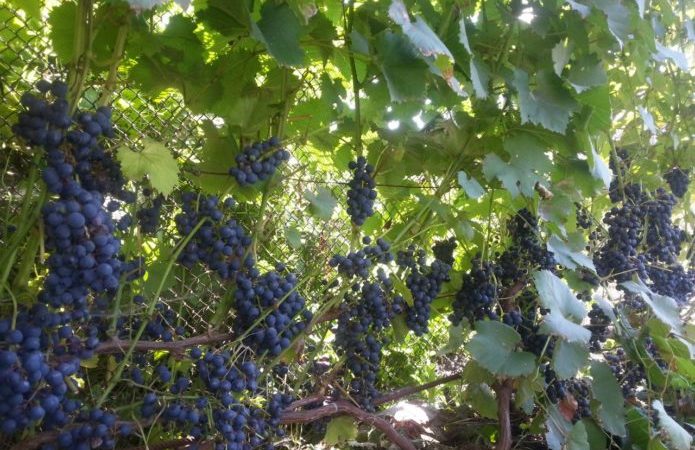
The bushes are characterized by an average vigor of growth, without additional sprinkling, they are weak. Annual shoots ripen completely.
The crown of young shoots is light green with pinkish-bronze denticles and is covered with slight bristly pubescence.
Young foliage is green, the back of the leaf plate is slightly pubescent. Shoots are light green. Annual ripe shoots are light brown, the nodes are also brown. Leaves are medium in size and large, weakly and moderately dissected, 3- and 5-lobed, less often whole, weakly funnel-shaped, the edges are slightly bent down, sometimes blistery. The upper notches in the form of an inward angle are shallow or of medium depth, open, lyre-shaped, less often closed. The lumen is ovoid or oval.
The petiolate notch is lyre-shaped, open, vaulted. The terminal teeth are triangular, the base is wide and pointed, the apex is elongated. The marginal denticles are acute, triangular, dome-shaped. The flowers are bisexual.
The growing season is 134 days from the moment the buds open until the harvest, with a sum of active temperatures of 2651 ° C. For fresh consumption, the grapes are harvested in early September, and for making wine - in the third decade of September.
The number of fruitful shoots is 78%, 1.4 bunches are concentrated on one developed shoot, and 1.8 on a fruitful one.
Sustainability
The hybrid is resistant to frost down to -25 ... -27 ° С. It tolerates moisture deficit well and is able to bear fruit even in arid regions.
Early violet is resistant to mildew and gray rot, susceptible to mildew, bacterial cancer. The hybrid is not affected by the grape leafworm and phylloxera.
Characteristics and description of fruits
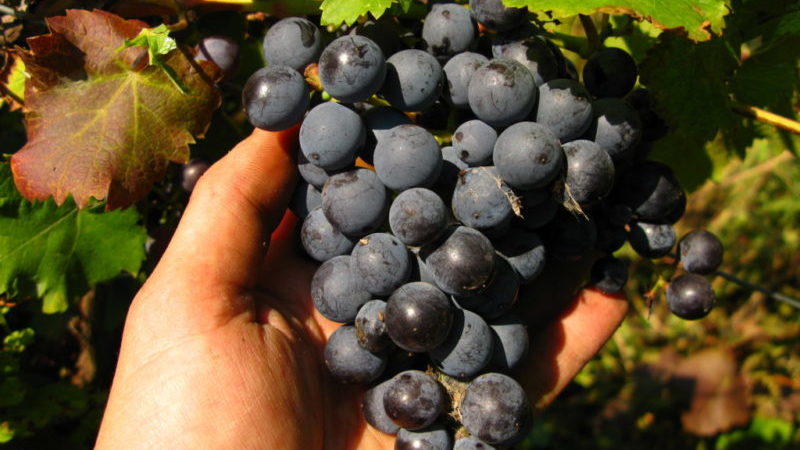
If spring comes early and summer is hot and dry, the first berries can be removed after 120 days. In regions of the middle lane and areas with short and cold summers, grapes rarely ripen before frost.
The weight of the berries is 2-3 g, in areas with additional irrigation - 4-6 g. To maintain fruiting, normalization of the brushes is required.
The skin is dark purple, enveloped in a dense waxy bloom. The pulp is transparent, the juice has no color. The taste is sweet, pleasant, with a delicate nutmeg aroma. Each berry contains 2-3 seeds.
Hand length - 17 cm, maximum weight - 200 g. The shape is cylindrical, tapering towards the apex, sometimes with lateral branches. The bunch is loose, due to which the berries are perfectly blown and warm, therefore they do not grow moldy.
Sugar content - 16-22 g / 100 ml, acidity - 3.8 g / l, tasting score - 8.9 points.
Reference. On the basis of Violet Early, winemakers prepare a vintage dessert wine Muscat Steppe Rose with pronounced rose tones in taste and aroma.
Areas of use
Harvesting and processing of the crop is performed in dry, clear weather. The brushes are cut with scissors, supporting from below by the branches, but not by the berries. The brushes are placed in wooden boxes lined with newspaper or thick paper. Winegrowers advise not to touch the fruit in order to preserve the wax bloom.
This is a universal grape, it is used for fresh consumption, raisins and wine. Frozen berries are placed in a glass instead of ice or as a decoration.
For the preparation of wine, 2-3 grape varieties are taken, since on the basis of one Violet early one cannot get a drink with a pronounced taste due to the low acidity of the berries. The extracts preserve and prepare aromatic mash, grappa and brandy.
Advantages and disadvantages

Benefits:
- frost resistance up to -27 ° С;
- immunity to mildew and gray rot;
- early maturity;
- juicy berries with a nutmeg aroma;
- lack of peas;
- high productivity;
- unpretentiousness to the composition of the soil;
- the ability to cultivate grapes on the slopes of any orientation.
Disadvantages:
- predisposition to oidium and bacterial cancer;
- colorless juice with low acidity requires blending to make wine with a rich taste;
- the need for rationing the harvest.
Growing technology
Hybrid Violet early is completely not picky about the structure of the soil, which makes it easy to plant.
There is no need to dig deep holes or trenches and fill them with loose soil. However, the instability of the culture to powdery mildew requires more attention and preventive spraying from winegrowers.
Terms and rules of landing
Early purple grows well on clay soil. In the south, you don't have to look for the sunniest place for it. landing... In a large vineyard where several varieties are grown, the most illuminated areas are assigned to late and large-fruited varieties.
A seedling in a container is planted from May to October, with an open root system - in spring or autumn.
The landing site is prepared in 2-3 weeks:
- dig a hole 50-60 cm deep and wide;
- crushed stone, expanded clay, broken brick, pieces of thick branches with a layer of 10 cm are poured to the bottom;
- the ground from the upper layer is mixed with river sand, peat, humus 1: 1;
- 500 g of ash and 50 g of superphosphate are added to each pit, mixed with soil mixture and filled to the brim.
If the preparation of the pit is started 1-2 days before planting, the earth is shed deeply, they wait for it to sink, and the soil mixture is added. 24 hours before planting, the seedlings in containers are watered abundantly, and with an open root system, they are placed in a solution of "Epin" or "Zircon" (30-40 drops per 1 liter of water).
On the day of planting, holes are dug on the site according to the scheme 1x1.5 m, seedlings are planted, watered and mulched with peat, humus, straw, dry leaves.
If the grapes are grown as a covering crop without a trunk, the seedlings are buried to the first branch on the trunk. Flexible vines are left on the surface, which are bent to the ground for the winter.
Further care
A year after planting, the shoots are tied to high stakes, and the next year, reliable permanent trellises are installed.
Pruning grapes performed in the spring before the start of sap flow.
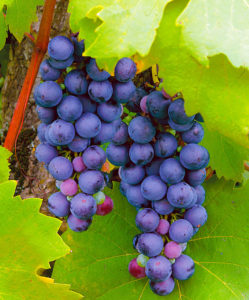 When growing a hybrid, 2 methods of molding are used: standard-free in 4 sleeves with covering viticulture, standard in 2 shoulders with non-covering. The height of the trunk is 1.2 m.
When growing a hybrid, 2 methods of molding are used: standard-free in 4 sleeves with covering viticulture, standard in 2 shoulders with non-covering. The height of the trunk is 1.2 m.
It is recommended to leave 5-7 eyes on each sleeve, on each shoot - 1-2 clusters. This method of rationing allows you to control the load on each bush.
In the year of planting, the hybrid is watered once every 2-3 weeks, subject to a moisture deficit. Water consumption for each bush is 20-30 liters. Overflows are not allowed, since water displaces oxygen from the soil, and the roots begin to rot at the same time.
Fruiting bushes need sprinkling:
- in early spring, taking into account weather conditions;
- before flowering;
- during the formation of berries.
Water consumption - 50-70 liters for each bush. When the berries increase in size and begin to color, watering is stopped. This is a general rule for watering the vineyard, but growers are advised to take into account the condition of the bushes, the weather and the structure of the soil.
If the plant has slowed down its growth ahead of time or there is a drought, additional watering is required. Clay soil poorly permeates moisture, and sandy, on the contrary, does not retain it. Under such growing conditions, grapes are watered 1.5 times more often. However, it is important to remember that excessive watering contributes to the leaching of nutrients from their soil and the development of chlorosis (yellowing) of the leaves.
In the first 3 years after planting, top dressing is not applied... The plant feeds on those nutrients that were originally introduced. At the first sign of stunted growth, the seedling feed by analogy with adult plants.
In autumn, most of the fertilizers are applied - 10-15 kg of compost or humus, 200 g of wood ash per bush. Around the base, at a distance of 0.5 m, an annular groove with a depth of 25 cm is formed. In the near-trunk circle, humus and ash are evenly laid out, watered with warm water and the groove is leveled.
Mullein-based liquid dressing is applied before bud break, 2 weeks before flowering, in summer at the time of berry formation. The slurry is diluted with water in a ratio of 1: 3. The container with the solution is placed in a warm place to accelerate fermentation. After a week, the top dressing is diluted with water 1: 5. Consumption per bush - 20 liters.
Top dressing applied simultaneously with watering or immediately after it. After 3-4 days, the soil under the bushes is powdered with 200-300 g of wood ash and loosened.
Reference. Nitrogen fertilizers should not be applied at the same time as wood ash. Lye reacts with nitrogen to form volatile ammonia, so most of the nutrients evaporate.
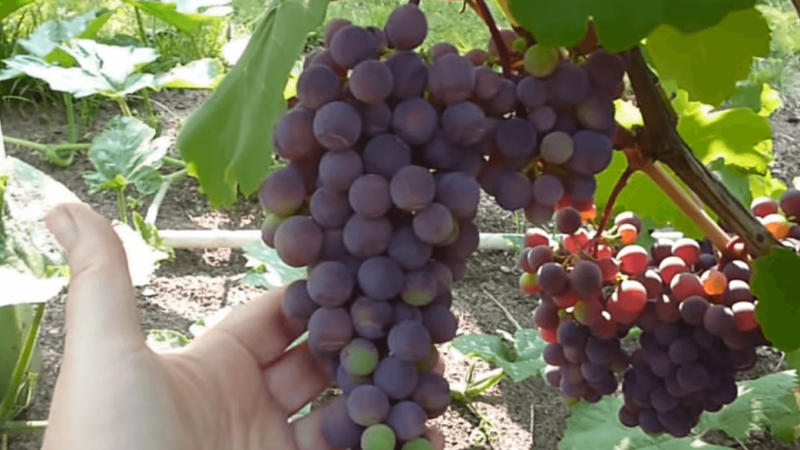
Possible problems, diseases, pests
To prevent powdery mildew, it is enough to carry out 2 preventive treatments with copper-containing preparations in spring and autumn.
HOM (40 g / 10 l) and a 1% solution of Bordeaux liquid are highly effective. When processing, make sure that the liquid completely moistens the leaves, vines and soil under the bushes. Yellow, dry leaves are removed from the area and burned.
Insect control is carried out before flowering and in the fall after harvest. The leaves are carefully sprayed with broad-spectrum insecticides: Karbofos, Aktara, Aktelik.
Before blooming the vineyard is cultivated "Nitrofenom" - once every 3-4 years. This drug is effective against fungi and insects.
Wintering
Early purple is able to withstand severe frosts, but it is still recommended to grow it as a cover crop.
The vines are removed from the supports, laid on the ground and covered with loose soil. This is done for the reason that ice rains can damage the plant in winter. The vine breaks under the weight of a thick layer of ice. As it melts, water penetrates under the kidney scales and freezes there, damaging them.
In the Urals, Siberia and regions of the middle zone, the hybrid is not very common, since the grapes do not have time to ripen before the onset of frost.
Reproduction
Violet early propagated by cuttings, layering and inoculationmaking it a versatile hybrid. The grapes are suitable even for novice gardeners who can use any convenient method of propagation.
Most often, growers practice propagation by cuttings due to the high efficiency of the method. Cuttings are harvested after leaf fall, before the first frost. For cutting, use a flexible vine with a dense core. Cut the cuttings of the branches of the current year with 4-6 developed buds, 50-70 cm long, 5-7 mm in diameter.
The workpieces are stored in a cool place (refrigerator, basement). The antennae and leaves are peeled off, the cuttings are dipped into melt water for a day, then into a solution of copper sulfate or potassium permanganate for disinfection. Prepared cuttings are wrapped in cellophane or folded in a plastic bottle. Storage temperature is 0 ... + 4 ° С. Once a month, the blanks are checked; if mold appears on them, they are washed in a strong solution of potassium permanganate.
In the spring, cuts are made at the ends to determine the viability of the cuttings. If drops of moisture come out, then the material is ready for planting; if not, it has dried up. Good quality cuttings should be light green when cut. Dark spots indicate infection.
Viable cuttings are cut and immersed in clean water for 48 hours. The water is changed every 3 hours.
After soaking, the material is placed in a growth stimulator "Kornevin" or "Heteroauxin" for half an hour and transferred to a container with wet sawdust. In such conditions, cuttings are stored for 10-15 days. After the appearance of root shoots, the cuttings are placed in a bottle of water until a full-fledged root system is formed.
Reproduction by layering is the least effective way. It is used when the plant is poorly rooted by cuttings. The method of EI Zakharov was widely used in the Rostov region when growing Violet early. Cuttings are obtained by rooting green or mature vines, not isolated from the mother bush.
In the spring, before bud break, annual branches or vines with developed shoots 10-12 cm long are placed in 15-20 cm depressions. The bottom is covered with nutrient soil with humus and minerals.
The vines are fastened with hairpins made of metal or wood, covered with loose soil with a layer of 5-10 cm and moistened. If green shoots are present on the vine, it is covered so that the leaves remain on the surface. As the shoots develop, the grooves are completely covered with soil. Roots are formed on the nodes and internodes, and shoots are formed from healthy eyes.
With the help of grafting, it is possible to achieve the transplantation of one plant to another and their fusion into a single organism. The transplant is performed at different stages of development, at different ages. The variety, species, genus do not matter. An annual matured or green stalk or a separate peephole is used as a scion.
The most popular method is cleft grafting. It is used before the start of sap flow. Cuttings harvested in autumn are fixed in a wedge-shaped cut so that the outer sides fall on the developed part of the wood. The upper cut of the cutting is made 2-3 cm above the node.
Winegrowers reviews
Early purple is widespread in the south of Russia. Here it is grown almost everywhere and is appreciated for unpretentious care and excellent taste.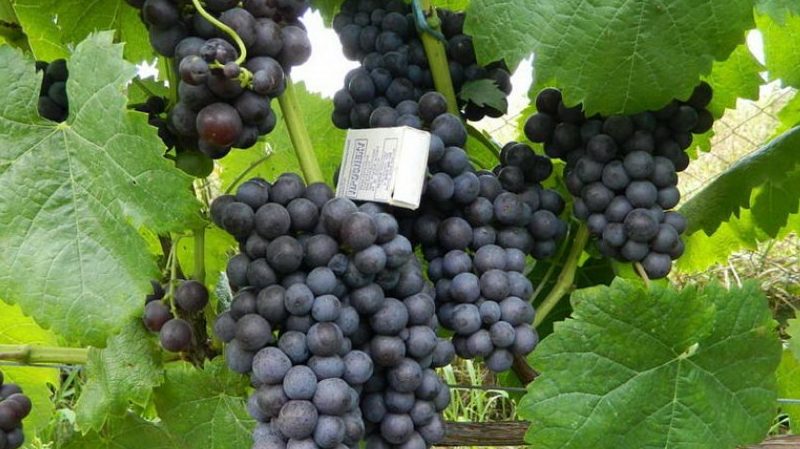
Kirill, Pyatigorsk: “I have been growing these grapes for 10 years now and I cannot get enough of it. The wine made from it has a strong taste and a bright aroma of rose mixed with nutmeg. To maintain fruiting, I regularly spray it, especially in the heat. "
Inna, Volgograd: “Early purple is a great variety for those who don't want to bother with grooming. The plant rarely gets sick, even with very common powdery mildew. For prophylaxis I spray the vineyard with the preparation "HOM" in spring and autumn.The berries are tasty, sweet, suitable for universal use. "
Conclusion
Early purple is a universal hybrid. It is suitable for novice winegrowers, since it is characterized by unpretentious care, winter and drought resistance, and strong immunity.
The plant needs rationing of bunches and additional irrigation to maintain fruiting. Berries are eaten fresh, wines and raisins are prepared. The culture is propagated by cuttings, layering and grafting. For the winter, the vine is covered to prevent the buds from freezing.